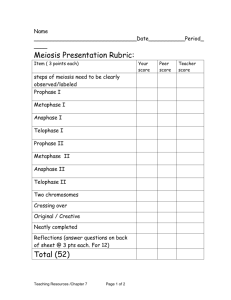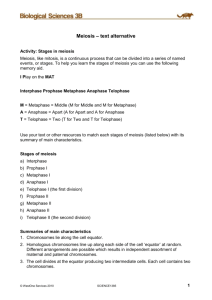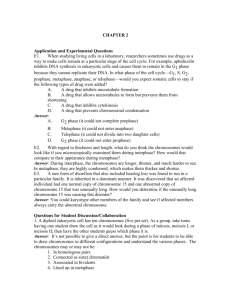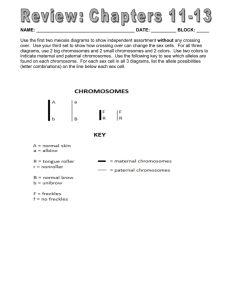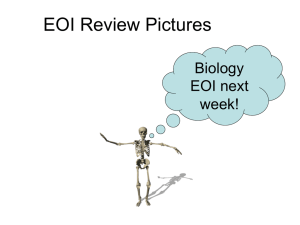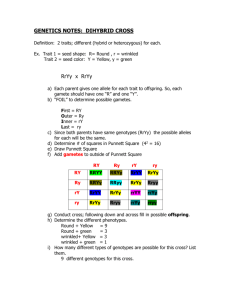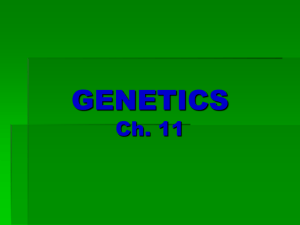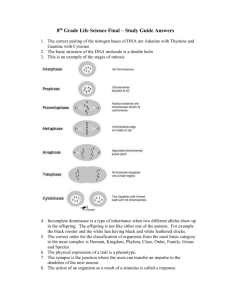Meiosis & Genetics Study Guide: High School Biology
advertisement
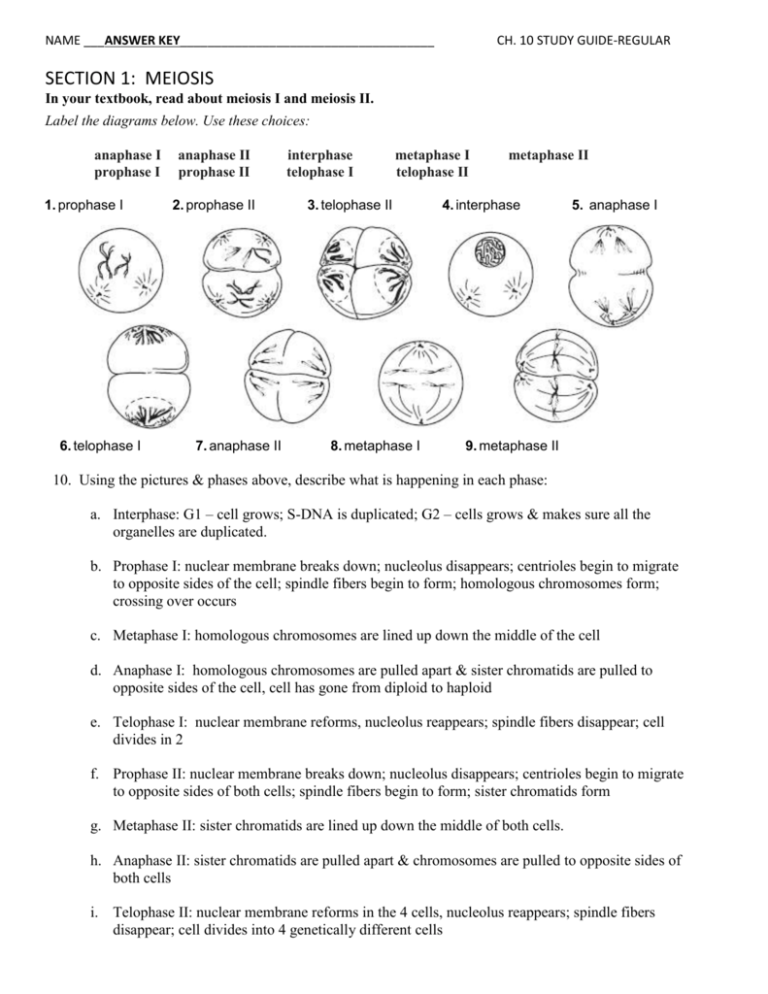
NAME ___ANSWER KEY_____________________________________ CH. 10 STUDY GUIDE-REGULAR SECTION 1: MEIOSIS In your textbook, read about meiosis I and meiosis II. Label the diagrams below. Use these choices: anaphase I prophase I 1. prophase I 6. telophase I anaphase II prophase II 2. prophase II 7. anaphase II interphase telophase I metaphase I telophase II 3. telophase II 8. metaphase I metaphase II 4. interphase 5. anaphase I 9. metaphase II 10. Using the pictures & phases above, describe what is happening in each phase: a. Interphase: G1 – cell grows; S-DNA is duplicated; G2 – cells grows & makes sure all the organelles are duplicated. b. Prophase I: nuclear membrane breaks down; nucleolus disappears; centrioles begin to migrate to opposite sides of the cell; spindle fibers begin to form; homologous chromosomes form; crossing over occurs c. Metaphase I: homologous chromosomes are lined up down the middle of the cell d. Anaphase I: homologous chromosomes are pulled apart & sister chromatids are pulled to opposite sides of the cell, cell has gone from diploid to haploid e. Telophase I: nuclear membrane reforms, nucleolus reappears; spindle fibers disappear; cell divides in 2 f. Prophase II: nuclear membrane breaks down; nucleolus disappears; centrioles begin to migrate to opposite sides of both cells; spindle fibers begin to form; sister chromatids form g. Metaphase II: sister chromatids are lined up down the middle of both cells. h. Anaphase II: sister chromatids are pulled apart & chromosomes are pulled to opposite sides of both cells i. Telophase II: nuclear membrane reforms in the 4 cells, nucleolus reappears; spindle fibers disappear; cell divides into 4 genetically different cells 11. What stage of meiosis will the cell go from diploid (2n) to haploid (n)? anaphase I 12. What is fertilization? Where an egg & sperm cells join creating a diploid cell 13. What is crossing over? Draw a picture. Crossing over is the exchange of genetic material between 2 homologous chromosomes 14. Explain how crossing over causes genetic variation. Creates different combinations of genes on chromosomes 15. How many chromosomes are in a typical human body cell? 46 16. How many chromosomes are in a typical egg or sperm cell? 23 = egg; 23=sperm 17. What is the role of the spindle fibers? To move the chromosomes around the cell to allow meiosis to take place Complete the table by checking the correct column(s) for each description. Description Mitosis Meiosis X 18. Involved in the production of gametes X 19. Involved in growth and repair X 20. Promotes genetic variation in organisms 21. Consists of one nuclear division X 22. Produces daughter cells that are genetically identical X 23. Involves two sets of nuclear divisions X 24. Produces daughter cells that are not identical X 25. Results in four haploid gametes X 26. Also called reduction division X SECTION 2: MENDELIAN GENETICS In your textbook, read about how genetics began and the inheritance of traits. Write the term or phrase that best completes each statement. Use these choices: cross-pollination recessive dominant self-fertilization gametes trait inherited 1. Mendel was the first person to succeed in predicting how traits are INHERITED from generation to generation. 2. In peas, both male and female sex cells, which are called GAMETES, are in the same flower. 3. SELF-FERTILIZATION occurs when a male gamete fuses with a female gamete in the same flower. 4. Mendel used the technique called CROSS-POLLINATION to breed one plant with another. 5. Mendel studied only one TRAIT at a time and analyzed his data mathematically. 6. In individuals with a heterozygous genotype, the RECESSIVE allele of a trait is hidden by the expression of the other phenotype. 7. In individuals with a heterozygous genotype, the DOMINANT allele of a trait is visible in the phenotype. 8. Describe heterozygous. When an organism’s chromosomes contain 2 different alleles for a particular trait 9. Explain why sexual reproduction is better in a frequently changing environment. When the environment is changing having the greatest genetic diversity ensures that members of the population will survive. 10. What is phenotype? The observable expression of a trait. 11. What is genotype? The allele pairs of an organism 12. Describe Mendel’s law of independent assortment. Mendelian law stating that a random distribution of alleles occurs during the formation of gametes. 13. Describe Mendel’s law of segregation. Mendelian law stating that 2 alleles for each trait separate during meiosis. In your textbook, read about Punnett squares. Complete the Punnett square by filling in the missing information. A student crossed true-breeding pea plants that had purple flowers (P) with true-breeding pea plants that had white flowers (p). All of the offspring had purple flowers. Then the student crossed two plants from the F1 generation. The student’s Punnett square is shown at right. What information should the student put in each blank? Remember, the dominant allele is always written first. Possible gametes 14. P 16. 15. P p 17. PP Pp In your textbook, read about the inheritance of traits and Punnett squares. Use each of the terms below only once to complete the passage. dihybrid gene genotypes monohybrid phenotypic ratio A cross between plants that involves one characteristic is called a (19) MONOHYBRID cross. Mendel also performed (20) DIHYBRID crosses, which involve two (21) GENE pairs, with pea plants. When he crossed two pea plants that were heterozygous for both seed shape (Rr) and for seed color (Yy), he observed a 9:3:3:1 (22) PHENOTYPIC RATIO among the seeds of the offspring. A Punnett square shows the possible phenotypes and (23) GENOTYPES of the offspring. p Pp 18. pp Complete the Punnett square by filling in the missing information. Possible gametes Ry RY 24. RY RRYY round, yellow 26. Ry RRYy round, yellow RRYy round, yellow 27. RRyy round, green 30. rY RrYY round, yellow 33. ry RrYy round, yellow rY ry 25. RrYY RrYy round, yellow round, yellow 28. RrYy round, yellow 31. 29. Rryy round, green 32. RrYy rrYY rrYy round, yellow wrinkled, yellowwrinkled, yellow 34. 35. 36. rrYy rryy Rryy wrinkled, yellow wrinkled, green round, green In your textbook, read about probability. Refer to the Punnett square above. Respond to the following statement. 37. Find the probability that a wrinkled, green seed will result. 1/16 SECTION 10.3 GENE LINKAGE & POLYPLODY In your textbook, read about genetic recombination and gene linkage. Match the definition in Column A with the term in Column B. Column A Column B C 38.genes that are located on the same chromosome A. chromosome map A 39.shows the location of several genes B. genetic recombination D 40.Drosophila melanogaster C. linked genes B 41.an outcome of independent assortment D. fruit fly For each statement below, write true or false. F 42. Crossing over occurs more frequently between genes that are close together on a chromosome. F 43. Gene linkage was first studied by using garden peas. T 44. Scientists call a drawing like the one shown above a chromosome map. In your textbook, read about polyploidy. Respond to each statement. 45. Recall the name for the occurrence of one or more extra sets of all the chromosomes in an organism’s cells. POLYPLOIDY
